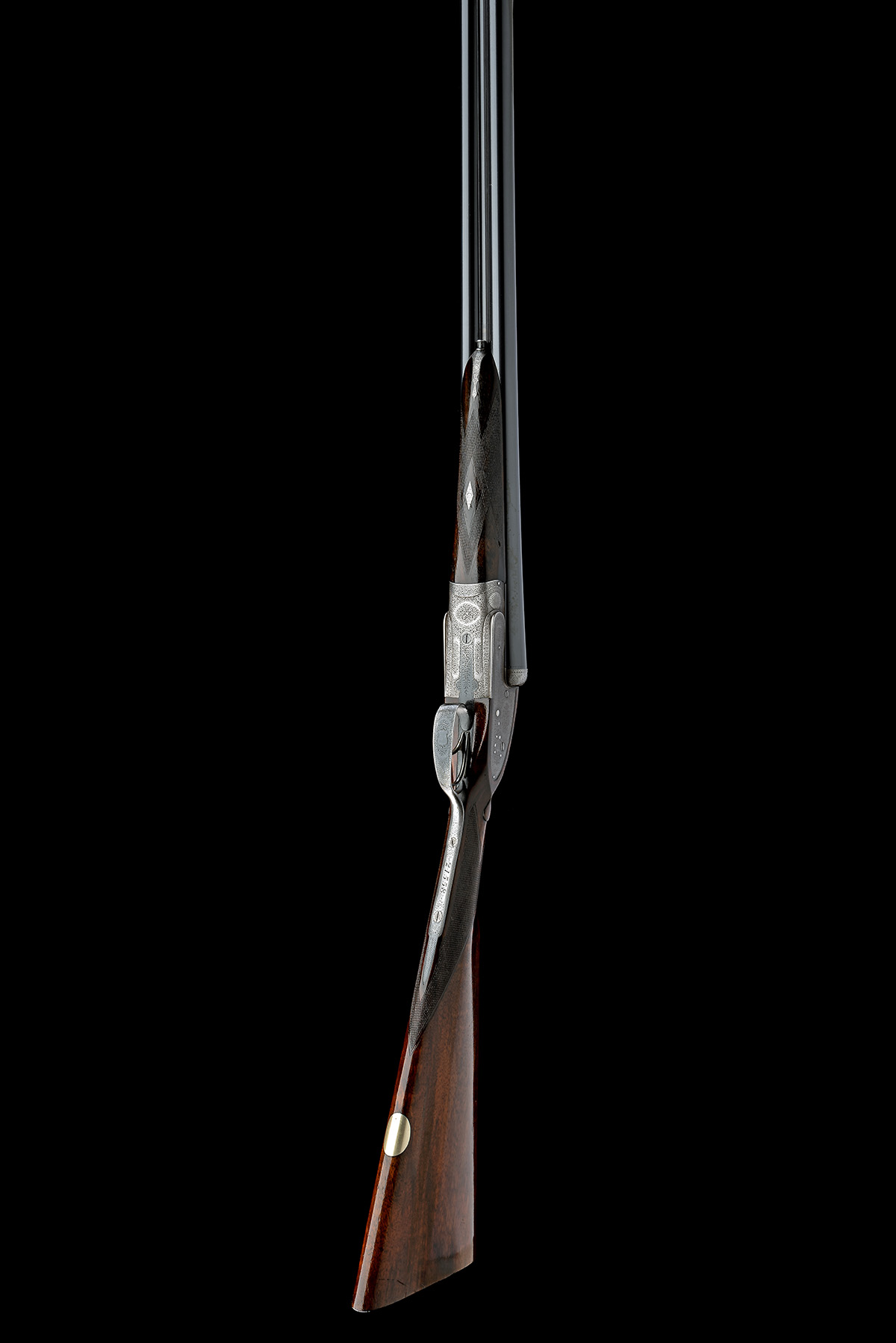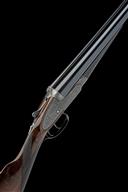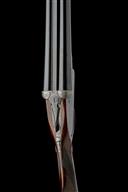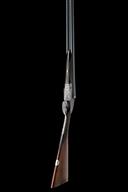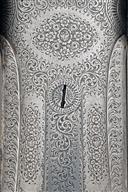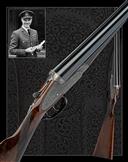Product Details
FORMERLY THE PROPERTY OF FLT. LIEUT. BILL REID V.C.
ARMY & NAVY C.S.L.
A 12-BORE SIDELOCK EJECTOR, serial no. 21558,
circa 1900, 30in. nitro barrels, rib engraved 'ARMY & NAVY C.S.L. LONDON.', some pitting to right tube, 2 1/2in. chambers, bored approx. true cyl. and 1/4 choke, automatic safety with blue enamelled 'SAFE' detail, best bouquet and scroll engraving, retaining slight traces of original colour-hardening, 14 1/2in. replacement stock, weight 6lb. 14oz.
Provenance: Reid was born 1921 in Glasgow and joined the R.A.F. Volunteer Reserve in 1940. After 'ab initio' training he received his wings and was sent to a Bomber Command O.T.U. before being posted to an operational squadron; in his case 61 Squadron based at R.A.F. Skellingthorpe. The Squadron was in the process of converting to, arguably, the finest heavy bomber of the Second World War; the Avro Lancaster.
Night operations on the 3rd November 1943 saw Reid as pilot-in-command of Lancaster 'O' Oboe with the mission of bombing the industrial area of Dusseldorf. Soon after crossing the Dutch coast, Reid's aircraft was attacked by a Messerschmitt 110 night fighter. The 110 was driven off by the mid-upper and rear gunners but not before damaging the rear turret, shattering the pilot's canopy and wounding Reid in the head, shoulders and hand. Very soon after, the Lancaster was attacked by a second fighter which wounded Reid further, killed the navigator and fatally injured the radio-operator. It was only the rear gunner with one functioning Browning remaining who managed to ward off the Messerschmitt. The inter-com and oxygen systems were also put out of action in the attack.
'O' Oboe was now flying at circa 20,000 ft with the surviving crew using portable oxygen supplies and Reid fighting for sight through the shattered canopy. He would have been quite justified in returning home but he elected to carry on to Dusseldorf, still 200 miles away.
Reid had memorised his course and so, despite the loss of his navigator, was able to place himself exactly over the target, quite a feat of navigation even under normal circumstances. The bomb-aimer dropped directly on target (verified by the automatic camera each bomber carried) and Reid then turned for home setting a course using the Pole Star and the Moon. The combined effects of freezing air, loss of blood and shortage of oxygen caused Reid to slip into a state of semi-consciousness, but the bomb-aimer and flight engineer managed to keep the Lancaster in the air until Reid 'came to' over the North Sea. Despite his vision being badly impaired by blood from his head wound, he resumed command of the aircraft and managed to land in heavy mist without further injury to him or his crew even though one of the undercarriage legs collapsed on landing.
The citation for Reid's Victoria Cross concluded by saying: "Wounded in two attacks, Flight Lieutenant Reid showed superb courage and leadership in penetrating a further 200 miles into enemy territory to attack one of the most strongly defended targets in Germany. His tenacity and devotion to duty are beyond praise."
Due to his skill and bravery, Reid was posted to 617 Squadron 'The Dambusters' once he had recovered from his injuries. 617 was at that time under the capable hands of Wing Commander Leonard Cheshire who would later also be awarded the V.C. Reid flew several sorties until he was brought down by a most unusual incident on 31st July 1944.
The squadron were tasked with the job of destroying a railway tunnel at Rilly la Montagne near Paris that the Germans were using to store V1 flying bombs in. The idea was to drop 12,000lb 'Tallboy' bombs (designed by Barnes Wallis) at the tunnel mouths which would penetrate very deeply and bring down the tunnels by earthquake effect. Reid dropped his 'Tallboy' on target and the sortie went exactly to plan until another Lancaster flying above him with standard delayed-action bombs released its load early. Two of the bombs hit Reid's aircraft and whilst they didn't explode, they mortally wounded the Lancaster which went into an uncontrollable spin. Of the seven-man crew, only Reid and his radio-operator survived.
Reid spent the rest of the war as a P.O.W. mainly at Stalag Luft 111, the primary camp for captured R.A.F. personnel. The camp was liberated by the Russians in April 1945 and Reid was repatriated the following month. He returned home and after gaining a degree in agriculture from Glasgow University became great friends with Lady MacRobert. She unfortunately had lost all 3 of her sons - 2 died serving in the R.A.F. and the remaining son died in a civil flying accident before the war. She and Reid became very close and whilst Lady MacRobert employed him as estate manager of her 5000 acre estate in Aberdeenshire he soon became part of the family. The gun was a gift from Lady MacRobert's personal collection which he used constantly whilst working on the estate.
In 1961 for personal reasons Reid decided to leave the estate and joined Spillers Farm Feeds based in London where he spent a further 20 years as a national advisor. During this time he frequently went on shooting trips either for business entertaining clients or at the invitation of various friends who ran estates both in England and Scotland.
Latterly he retired to his native Scotland in 1980 and continued to indulge his love of shooting until shortly before his death in 2001.
Other Notes: Previously sold through these Rooms as Lot 1420, Thursday 17th September, 2009
Please click HERE to view Terms & Conditions. Please note all Lots are listed in accordance with UK Law, for overseas buyers, please ensure you are familiar with your relevant local firearms and customs regulations before bidding.
Estimate £1,200-1,600
S2 - Sold as a Section 2 Firearm under the 1968 Firearms Act

